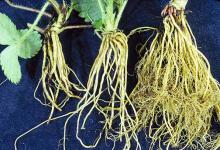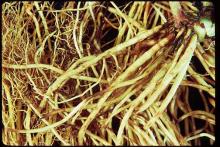See:
Strawberry (Fragaria spp.) - Black Root Rot Complex
Cause Pratylenchus penetrans and P. crenatus, nematodes that live in soil. The nematodes migrate through and feed in the root cortex. The surrounding root tissue dies and can be seen as discrete lesions. Legumes such as clover, alfalfa, and vetch often harbor large populations of root-lesion nematodes, which may affect future strawberry plantings. The number of nematodes in the soil can be a rough guide to possible plant damage. Factors such as crop age, planting frequency, presence of other diseases and pests, and adverse growing conditions influence the effect of certain nematode populations on plant growth. In some cases, 300 nematodes/100 g of soil affect plant growth, but much higher populations often have little effect. Root-lesion nematodes are migratory endoparasites; part of the population is in soil and part in the roots at all times.
Symptom Infected plants are dwarfed, off-color, and grow poorly. Reduced runner production, depressed yields, and shortened life of the planting also occur. Damage is frequently seen as spots in the field. Roots have individual brown lesions that can be so numerous that the root is girdled.
Sampling Always include soil and roots in samples sent for nematode analysis if plants are present. Take samples any time if the numbers are interpreted in relation to nematode population dynamics. In most crops, populations are relatively low through winter and spring but increase rapidly through summer. Before planting strawberries, it is best to sample in late summer.
Cultural control
- If possible rotate plantings to new land.
- Use certified plants.
- Fallow periods can disrupt the nematode life cycle. Practice good weed control using herbicides or tillage.
- Cover crops are an excellent way to disrupt the nematode life cycle. Care should be taken when selecting a cover crop to avoid use of a plant that is a host for the target nematode. In general, root-lesion nematodes have very broad host ranges, therefore, the selection of a non-host cover crop is difficult. Part of an effective cover crop is good weed control. Yellow mustard (Brassica juncea) contains allyl isothiocyanate, which is active against nematodes. Brassica carinata also has been reported to be effective against nematodes.
Chemical control
- Preplant soil fumigation.
- Basamid G. Avoid application when soil is over 90°F. Do not apply within 3 to 4 feet of growing plants. 5-day reentry Restricted-use pesticide.
- Dominus at 10 to 40 gal/A. Apply as a shank injection to an entire field or raised beds when soil temperatures are above 60°F but not greater than 90°F. 5-day reentry.
- Nimitz at 3.5 to 7 pints/treated A. Incorporated before a minimum of 7 days from planting. Effectiveness reduced on muck or high clay soils. 12-hr reentry.
- Telone II at 27 to 35 gal/A broadcast on mineral soils. Leave the soil undisturbed for at least 7 days after application. A longer interval, such as 2-3 weeks, is required if soils are cold or wet, or the site will be replanted with deep rooted trees, shrubs or vines. Odor indicates fumigant presence; do not plant until odor leaves the soil. Do not treat extremely heavy soils. 5-day reentry. Restricted-use pesticide.
- Telone C-17 at 27 to 41 gal/A broadcast on mineral soils. Leave the soil undisturbed for at least 7 days after application. A longer interval, such as 2-3 weeks, is required if soils are cold or wet, or the site will be replanted with deep rooted trees, shrubs or vines. Odor indicates fumigant presence; do not plant until odor leaves the soil. Do not treat extremely heavy soils. 5-day reentry. Restricted-use pesticide.
- Vapam HL at 37.5 to 75 gal/A. Immediately roll the soil and follow up with tarps or a light watering. May use through an irrigation system. 5-day reentry. Restricted-use pesticide.
- Ecozin Plus at 25 to 56 oz/A is registered for use after planting through a drip irrigation system. Label suggests using additives to aid penetration into the soil and to make applications in the morning. Efficacy in the Pacific Northwest is unknown. 4-hr reentry. O
- Nema-Q at 1.5 to 3 gal/A for the first application followed by 4 to 6 weekly applications at 2 quarts/A. Efficacy in the Pacific Northwest is unknown. 24-hr reentry.
- Velum Prime at 6 to 6.5 fl oz/A can be used after planting using drip, trickle of micro-sprinklers. May be applied day of harvest. Group 7 fungicide. 12-hr reentry.
Biological control
- Majestene at 4 to 8 quarts/A in sufficient water to thoroughly soak the root zone. Unknown efficacy in the PNW. Has not worked well in potato and raspberry systems. May be used day of harvest. 4-hr reentry. O
- MeloCon WG (Paecilomyces lilacinus strain 251) at 2 to 4 lb/A plus a soil wetting agent can be applied to established plants, although it might be better used when applied to plants just before planting. Stable for only days at room temperature, weeks in the refrigerator, or for a year if frozen. Unknown efficacy in the PNW. 4-hr reentry. O
Reference Pinkerton, J.N. and Kitner, M.L.C. 2006. Effects of biologically-derived products on mobility and reproduction of the root-lesion nematode, Pratylenchus penetrans, on strawberry. Nematropica 36:181-196.



